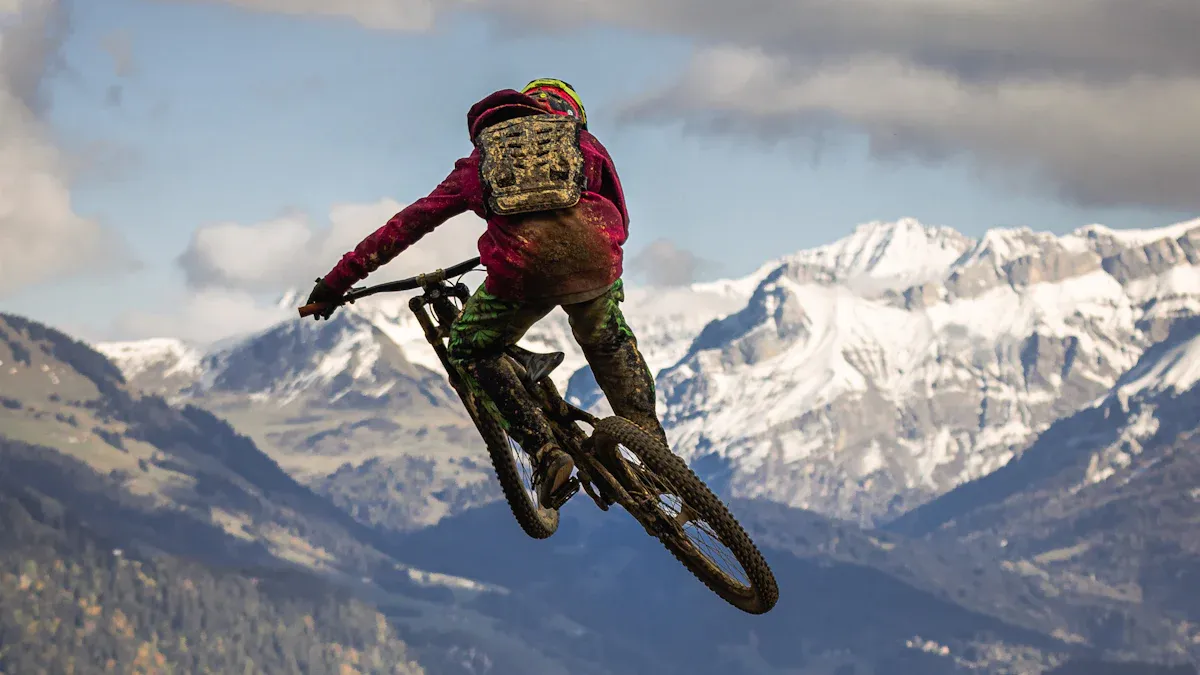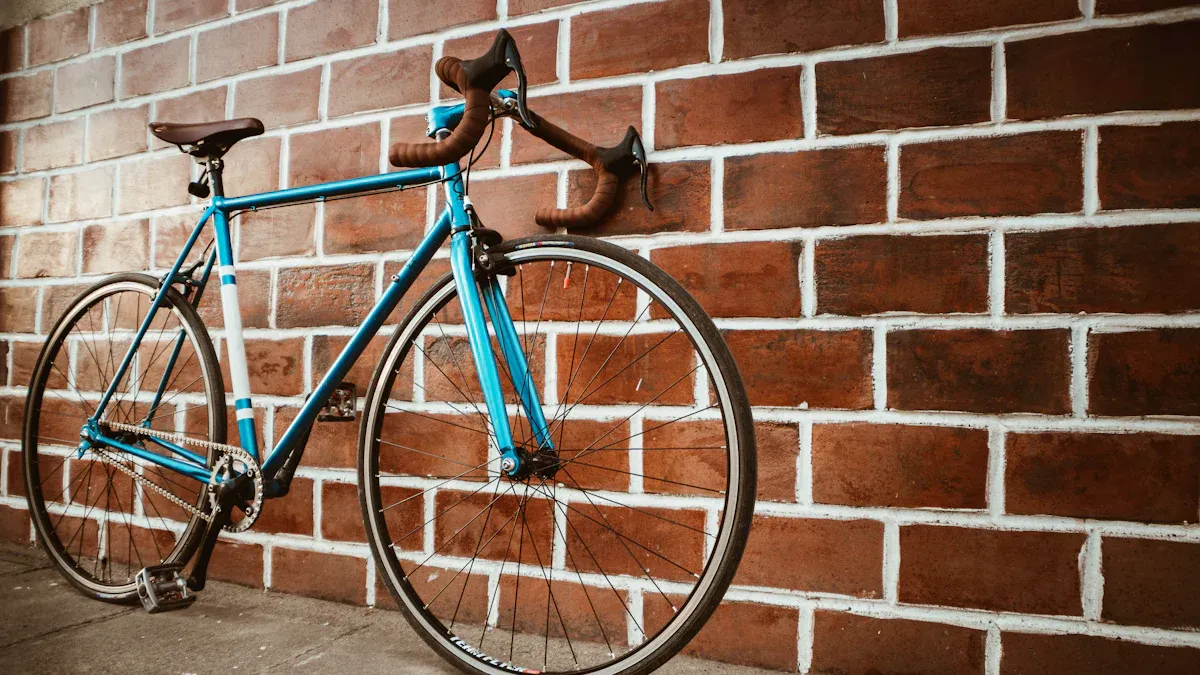
Choosing the right medium mountain bike frame is very important for your ride. It affects your performance and comfort on the trails. Your height is a big factor in finding the best fit. A frame that fits well helps you control the bike better. It also lets you handle different terrains easily. Think about your riding style. Do you like fast descents or easy trails? This will help you make your choice.
Key Takeaways
Picking the right frame size is very important for comfort and performance. Measure your height and inseam to find the best fit.
A bike that fits well helps you control it better and feel less discomfort. Try riding different sizes to see what feels good for you.
Think about how you ride when choosing a frame. Fast riders might like bigger frames for stability. Riders on tough trails may need smaller frames for easier turns.
Know important measurements like top tube and seat tube lengths. These affect how you sit and how well you pedal.
Take your time when choosing. A good fit makes rides better and more fun on the trails.
Frame Size Importance

Picking the right frame size for your medium mountain bike is very important. It can change how you ride. Let’s look at how frame size affects your performance and comfort on the trails.
Performance Implications
The size of your bike’s frame is key to how well you ride. Here are some important points to think about:
Reach Matters: The reach of your bike changes how it feels on the trail. A shorter frame makes it easier to turn quickly. This helps you handle tight turns and tricky spots. A longer frame gives you stability when going fast. This helps you stay in control on tough terrain.
Efficiency and Speed: Studies show that frame size affects how well you ride and your speed. A bike that fits you well helps you pedal better. This means less tiredness and better performance. With the right mountain bike size, you can climb and go down hills with confidence.
Comfort and Control
Comfort is just as important as performance when picking your mountain bike frame size. A good fit helps you stay in control and enjoy your ride. Here’s what you should know:
Avoiding Discomfort: Picking the wrong bike size can cause problems. Riders often feel pain, especially in their back, neck, and shoulders. If your frame is too small, you might feel squished. A frame that is too big can make it hard to reach the handlebars and pedals.
Control on the Trail: A bike that fits well lets you move easily. If your frame is too small, you may have trouble with steep climbs. This is because of front-wheel flop. On the other hand, a frame that is too big can make it hard to turn in tight spots and go down hills slowly. This can lower your control and performance on the trails.
Mountain Bike Size Chart
When it comes to choosing the right mountain bike size, a size chart can be your best friend. It helps you find the perfect fit based on your height and riding style. Let’s break down how to use a mountain bike size chart effectively.
Key Measurements for Mountain Bike Frame Size

When choosing a medium mountain bike frame, two key measurements stand out: top tube length and seat tube length. Understanding these dimensions can help you find the right mountain bike fit for your riding style.
Top Tube Length
The top tube length plays a significant role in your comfort and control on the bike. Here’s how it affects your ride:
Rider Posture: A longer top tube can provide comfort during descents. However, it may hinder your climbing efficiency due to weight distribution. For instance, a rider who is 6′ tall with a long torso finds that a longer top tube suits their body proportions well. On the other hand, shorter riders might benefit from a shorter top tube to avoid knee interference with the stem. This design helps them maintain a more comfortable riding position.
Fit and Performance: The right top tube length can enhance your overall riding experience. If you feel cramped, it might be time to consider a different frame size. A well-fitted bike allows you to maneuver easily, especially on technical trails.
Seat Tube Length
The seat tube length is another crucial measurement that impacts your mountain bike fit. Here’s what you need to know:
Size | Seat Tube Length | Rider Height Range |
|---|---|---|
M | 5’6″ – 5’10” (168 – 178 cm) |
A longer seat tube elevates you, which is beneficial for climbing. It helps you maintain an efficient pedaling position, leading to better power transfer. Conversely, a slacker angle can hinder your pedaling efficiency due to less effective leg alignment. So, when sizing your mountain bike, consider how the seat tube length aligns with your inseam and overall height.
Finding the right mountain bike size involves understanding these measurements. Use an online bike size calculator to help you determine the best fit for your needs. Remember, a wrong bike size can lead to discomfort and reduced performance on the trails.
Common Sizing Dilemmas
Choosing the right mountain bike size can be hard. You may wonder if you should go bigger or smaller. Let’s explain it.
When to Size Up
You should think about sizing up if you find yourself in these situations:
Riding Style: If you ride fast, a bigger frame gives more stability. This is important for high-speed descents. A longer wheelbase helps you stay in control.
Skill Level: Experienced riders usually handle larger frames better. They can manage the extra size for better stability. But if you are new to mountain biking, a larger frame might feel heavy and hard to control.
Position Preference: If you like a more aggressive riding position, choose a larger frame. It can help your performance on tough trails.
When to Size Down
On the other hand, sizing down can be good in some cases:
Advantages | Disadvantages |
|---|---|
More lively handling for tight turns | Less stable due to shorter wheelbase |
Lighter and more compact | Slightly less reliable, may break easier |
Better maneuverability in difficult terrain | More stress on frame because of longer parts |
If you often ride on tricky terrain, a smaller frame can help you get through tight spots easily. But remember, it may lose some stability.
The Role of Test Riding
Test riding is very important for finding the right mountain bike fit. Here’s why:
Personal Preferences: Everyone has different likes. What feels good for one person may not work for another.
Complexities of Fit: Your height, inseam, and riding style all matter. Experts say no online bike size calculator can replace trying out a bike in person.
Retailer Support: Many bike shops, like Kozy’s Bike Shops and Berkshire Bike & Board, let you test ride bikes. Use this chance to see how different sizes feel.
In the end, take your time with your choice. Test riding helps you learn what works best for you. This way, you can pick the right bike size for your adventures.
Choosing the right medium mountain bike frame is all about you. Your likes and how you ride are very important for finding the best fit. Here are some key points to remember:
Fit and Sizing: A good fit helps you feel comfortable and ride well. Measure your inseam to find the right size.
Frame Types: Think about choices like hardtail, full suspension, or rigid based on how you ride.
Material Matters: Different materials, like aluminum or carbon, change weight and ride quality.
Riding Style: Your height and body shape affect your comfort and performance on the trails.
Take your time when making this big choice. Test riding different frames can help you find what feels best for you. Happy riding! 🚴♂️
FAQ
What size frame should I choose if I’m 5’8″?
If you are 5’8″, a medium frame (17 inches) usually works well. But think about your inseam and how you ride. Test riding can help you find the best fit.
How do I know if my bike frame is too big?
If you have trouble reaching the handlebars or feel wobbly during turns, your frame might be too big. You should feel relaxed and in control while riding.
Can I adjust my bike if it’s the wrong size?
Yes! You can change things like the seat height or handlebar position. But if the size is very off, you might need a different frame for better comfort and performance.
Why is frame geometry important?
Frame geometry affects how your bike rides. It impacts stability, comfort, and how quickly you respond. A good design helps you ride on different terrains easily.
Should I prioritize comfort or performance when choosing a frame?
Both comfort and performance are important. A comfy bike lets you ride longer, while a performance frame boosts speed and control. Find a mix that fits your riding style.
See Also
Key Factors to Evaluate for E-Mountain Bike Frames
Guidelines for Selecting the Ideal Carbon Mountain Bike Frame
Steps to Select the Perfect Bike Frame for You
Finding the Best Bike Frame for Optimal Comfort and Performance
